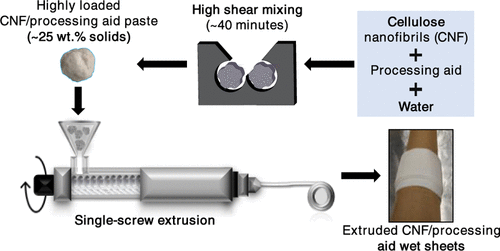当前位置:
X-MOL 学术
›
ACS Appl. Polym. Mater.
›
论文详情
Our official English website, www.x-mol.net, welcomes your
feedback! (Note: you will need to create a separate account there.)
Continuous Processing of Cellulose Nanofibril Sheets Through Conventional Single-Screw Extrusion
ACS Applied Polymer Materials ( IF 4.4 ) Pub Date : 2020-06-25 , DOI: 10.1021/acsapm.0c00477 Sami M. El Awad Azrak 1 , William J. Costakis 1 , Robert J. Moon 2 , Gregory T. Schueneman 2 , Jeffrey P. Youngblood 1
ACS Applied Polymer Materials ( IF 4.4 ) Pub Date : 2020-06-25 , DOI: 10.1021/acsapm.0c00477 Sami M. El Awad Azrak 1 , William J. Costakis 1 , Robert J. Moon 2 , Gregory T. Schueneman 2 , Jeffrey P. Youngblood 1
Affiliation

|
Extrusion-based processes are one of the most widely used continuous polymer processing techniques because of their commercial availability, versatility, and cost-effective scalability. For these reasons, conventional single-screw extrusion was investigated and used for continuously processing mechanically fibrillated cellulose nanofibrils (CNFs) into wet sheets. A high shear mixing procedure was used to process highly loaded CNF pastes with up to ∼25 wt % solids, composed of ∼91 wt % CNF and ≤ ∼9 wt % of a processing aid like carboxymethyl cellulose (CMC), xanthan gum (XG), or anionic polyacrylamide (aPAM). Validation of the mixing procedure proved that highly loaded CNF/processing aid pastes can be processed in under 40 min. The higher solid loadings significantly reduced the preparation and drying time. The water-retention ability and stability of CNF suspensions containing different processing aids were assessed through centrifugation and zeta potential analysis. Extrusion of the prepared pastes showed that cohesive sheets could be produced continuously at output rates of 7.45 ± 0.47 kg/h (or 1.14 ± 0.072 dry) without the introduction of surface defects. Wet extrudates with an average width of ∼5 cm and thickness of 1.46 ± 0.05 mm were continuously processed, with the length limited only by the lack of collection rolls. A viscosity–shear rate dependence analysis linked extrudate homogeneity and reduced defects to a stronger Newtonian response for CNF/CMC pastes when compared to pure CNFs. On the other hand, CNF/XG and CNF/aPAM pastes experienced a much stronger shear thinning response, which correlated with a stronger appearance of observable aggregates and pinhole defects in the extrudates. Tensile testing of the pressed and heated CNF/CMC extrudates revealed equivalent mechanical properties to cast CNF films prepared through conventional solution casting. Lastly, preliminary calendering results for CNF/CMC extrudates showed that full consolidation can be achieved, thus providing a way to continuously dry and press the wet extrudates.
中文翻译:

通过常规的单螺杆挤出连续加工纤维素纳米原纤维片
基于挤出的工艺由于其商业上的可获得性,多功能性和具有成本效益的可扩展性而成为最广泛使用的连续聚合物加工技术之一。由于这些原因,对常规的单螺杆挤出进行了研究,并将其用于将机械原纤化的纤维素纳米原纤维(CNF)连续加工成湿片。高剪切混合程序用于处理固体含量高达约25 wt%的高负载CNF浆料,它由约91 wt%CNF和≤约9 wt%的加工助剂如羧甲基纤维素(CMC),黄原胶(XG)组成)或阴离子聚丙烯酰胺(aPAM)。混合程序的验证证明,高负载的CNF /加工助剂浆料可以在40分钟内加工。较高的固体载量显着减少了制备和干燥时间。通过离心和ζ电势分析评估了含有不同加工助剂的CNF悬浮液的保水能力和稳定性。制备的糊料的挤出显示,可以以7.45±0.47 kg / h(或1.14±0.072干)的输出速率连续生产粘结片,而不会引入表面缺陷。连续加工平均宽度约为5厘米,厚度为1.46±0.05毫米的湿挤出物,其长度仅受缺少收集辊的限制。与纯CNF相比,粘度-剪切速率依赖性分析将挤出物的均匀性和减少的缺陷与CNF / CMC浆料的牛顿响应联系起来。另一方面,CNF / XG和CNF / aPAM浆料的剪切稀化响应要强得多,这与挤出物中可观察到的聚集体和针孔缺陷的更强外观有关。加压和加热的CNF / CMC挤出物的拉伸测试显示出与通过常规溶液流延制备的流延CNF膜等效的机械性能。最后,CNF / CMC挤出物的初步压延结果表明可以实现完全固结,从而提供了一种连续干燥和压制湿挤出物的方法。
更新日期:2020-08-14
中文翻译:

通过常规的单螺杆挤出连续加工纤维素纳米原纤维片
基于挤出的工艺由于其商业上的可获得性,多功能性和具有成本效益的可扩展性而成为最广泛使用的连续聚合物加工技术之一。由于这些原因,对常规的单螺杆挤出进行了研究,并将其用于将机械原纤化的纤维素纳米原纤维(CNF)连续加工成湿片。高剪切混合程序用于处理固体含量高达约25 wt%的高负载CNF浆料,它由约91 wt%CNF和≤约9 wt%的加工助剂如羧甲基纤维素(CMC),黄原胶(XG)组成)或阴离子聚丙烯酰胺(aPAM)。混合程序的验证证明,高负载的CNF /加工助剂浆料可以在40分钟内加工。较高的固体载量显着减少了制备和干燥时间。通过离心和ζ电势分析评估了含有不同加工助剂的CNF悬浮液的保水能力和稳定性。制备的糊料的挤出显示,可以以7.45±0.47 kg / h(或1.14±0.072干)的输出速率连续生产粘结片,而不会引入表面缺陷。连续加工平均宽度约为5厘米,厚度为1.46±0.05毫米的湿挤出物,其长度仅受缺少收集辊的限制。与纯CNF相比,粘度-剪切速率依赖性分析将挤出物的均匀性和减少的缺陷与CNF / CMC浆料的牛顿响应联系起来。另一方面,CNF / XG和CNF / aPAM浆料的剪切稀化响应要强得多,这与挤出物中可观察到的聚集体和针孔缺陷的更强外观有关。加压和加热的CNF / CMC挤出物的拉伸测试显示出与通过常规溶液流延制备的流延CNF膜等效的机械性能。最后,CNF / CMC挤出物的初步压延结果表明可以实现完全固结,从而提供了一种连续干燥和压制湿挤出物的方法。











































 京公网安备 11010802027423号
京公网安备 11010802027423号